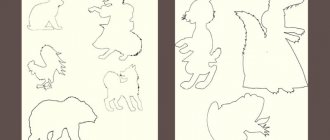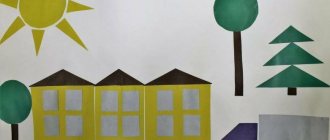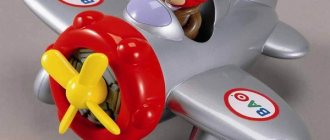Art project at the preschool educational institution
MUNICIPAL BUDGET PRESCHOOL EDUCATIONAL INSTITUTION "KINDERGARTEN No. 15 "Teremok" Gai, Orenburg region
Art projects in preschool education
in accordance with the objectives of the Federal State Educational Standard.
(summarizing experience)
Completed by: Kozlova A.M.
Higher education teacher
qualification category
One of the important principles of the Federal State Educational Standard for Preschool Education is the personal developmental and humanistic nature of interaction between adults (parents, legal representatives), preschool workers and children. In the educational field “Artistic and Aesthetic Development” the following are highlighted as priority goals in the Federal State Educational Standard for Education:
— development of prerequisites for value-semantic perception and understanding of works of art (verbal, musical, visual), the natural world;
- the formation of an aesthetic attitude towards the surrounding world;
— formation of elementary ideas about types of art;
- perception of music, fiction, folklore;
- stimulating empathy for the characters of works of art;
- implementation of independent creative activities of children (visual, constructive-model, musical).
The implementation of these principles and objectives is facilitated by project activities in preschool educational institutions. It is one of the options for an integrated method of teaching preschoolers, an effective way to organize the pedagogical process, based on the interaction of the teacher and students, ensuring the openness of the educational system of preschool educational institutions to the active participation of parents. This form of interaction between a child and an adult allows for the development of cognitive abilities, the personality of a preschooler, as well as relationships with peers.
In the conditions of preschool education, artistic or art projects that are closest to the polyartistic nature of the child are promising, during which, as a result of targeted, coordinated pedagogical influences, various types of art interact with the artistic and creative activities of children.
These projects are aimed at revealing to the child not only external, but also deep internal connections between music and other forms of art, teaching him to “see music” and “hear painting.” By cultivating the ability to “see” and “hear,” art creates the prerequisites for expanding and deepening children’s ideas about the world around them. Art projects significantly influence the mental development of preschool children: emotions and feelings, thinking, imagination, forming a harmony of sensory culture in children.
Project activities, in particular art projects, have become widespread in our MBDOU No. 15.
It should be noted that art projects as a cultural phenomenon largely develop according to the laws of dramaturgy and have common features with theatrical and musical dramaturgy, understood as “a sequence of stages in revealing the dramatic concept (exposition, plot, development, climax, denouement). Musical dramaturgy also implies the possibility of having an introductory stage in the work, in which the themes and images of the composition are reflected. The same introduction can precede an art project.
Management of project activities, in particular art projects, presupposes an understanding of their dramaturgy and, in connection with this, clear planning, highlighting its main stages. These include:
· introduction
– management and teachers, with the participation of parents, choose the topic of the project, discuss the goals, objectives, forms and methods of its implementation, divide responsibilities, find common ground in the content of the work of all its participants;
· exposition
– a series of classes is conducted with children devoted to the perception of the content of the project in various types of art (music, fine arts, fiction, theater). Cycles of unidirectional training sessions are also conducted here, which subsequently form the basis for various types of children's creativity (visual, musical-motor, theatrical);
· plot
– necessarily includes the preparation and holding of a cultural event (for example, a concert in a preschool educational institution, a visit to a musical theater, museum, library, etc.), which activates the interest of children and fills their perception with new colors. This same cultural event is essentially the first culmination, a point of high emotional intensity in the perception of preschoolers, their parents and teachers;
· development
– active experience of the content of the project through children’s creativity, reflection of what has been accumulated in various types of children’s creativity. As a rule, parents and teachers are actively involved in creative activities;
· result, denouement
– a vibrant cultural event, the main participants of which are children (musical performance, folklore festival, leisure, music room, etc.). This is another culmination of the project, since in it children convey all their feelings, experiences, and realize their creative abilities in various types of creativity.
At all stages, management, teachers and parents of the preschool institution take an active part in its implementation.
So, for example, in the process of implementing the art project “Pushkin Ball”:
— at the introduction stage, management and teachers developed the main activities of the project;
— at the second stage, we conducted one-directional lessons with children on listening to music, including familiarization with the works of N.A. Rimsky-Korsakov (“Flight of the Bumblebee” from the opera “The Tale of Tsar Saltan”) classes in visual arts that prepare preschoolers for the embodiment of literary images in drawings; speech classes (work on the expressiveness of reading poems);
— at the third stage, children and teachers visited the library. At the same time, a reading competition was held in the preschool educational institution;
— the fourth stage included a vernissage of children's drawings and an exhibition of creative works by children and parents based on the works of A.S. Pushkin;
— at the fifth stage, the “Pushkin Ball” was held, which became both a bright culmination and completion of the project.
The subject of art projects can be different, for example: “Fairy tale in music”, “Journey to the past”, “Different colors of autumn”, “Russian folk images”, etc. The main thing is that their content is bright, exciting and at the same time accessible to preschoolers.
Art projects are also very productive in terms of the creative growth of teachers, since they allow them to increase their level of competence on a particular issue and establish partnerships with students and their parents.
An analysis of the artistic and aesthetic direction of preschool educational institutions shows that art projects serve as an effective form of organizing pedagogical activities and provide:
— deepening ideas about various types of art, developing the artistic perception of preschoolers;
— intensification of creative activity;
- the formation of an aesthetic attitude towards the surrounding world;
— unity and integrity of the pedagogical process, interaction of all kindergarten teachers;
— increasing the participation of parents in the life of the preschool institution.
I invite you to take part in our mini art project “P.I. Chaikovsky. Seasons".
Target:
introduce children to P.I.’s album Tchaikovsky "Seasons".
Tasks:
- instill a love for classical music, for the work of P.I. Tchaikovsky; - develop musical taste and creative abilities of children; — teach to listen, analyze, understand the content of musical works; - learn to improvise, fantasize to music - enrich vocabulary, expressive reading skills.
Main events:
— conversations about the work of P.I. Tchaikovsky - listening to plays from the album "The Seasons" - looking at reproductions of paintings by artists of the 18th and 19th centuries - conversations about the spirit, traditions, culture of that era - depiction of musical pieces in drawings, modeling, appliqué - improvisations and sketches on a given topic - exhibition of children's drawings
—
final event “Musical Lounge”
"Seasons"
- a famous piano cycle by P. I. Tchaikovsky, consisting of 12 characteristic paintings.
The idea of the cycle and the title of the plays belonged to Nikolai Matveevich Bernard, publisher of the magazine “Nouvellist”, with whom Pyotr Ilyich had collaborated since 1873. Around November 1875, Bernard sent Tchaikovsky an order for a piano cycle. Bernard’s letter has not survived, but its contents can be easily imagined based on the composer’s response dated November 24, 1875: “I received your letter. I am very grateful to you for your kind willingness to pay me such a high fee. I will try not to lose face and please you. I will soon send you the first play, and maybe two or three at once. If nothing interferes, then things will go quickly: I am now very inclined to take up piano pieces. Your Tchaikovsky. I save all your titles"
. Consequently, the names of the plays, that is, the plots-pictures, were proposed to the composer by the publisher.
In December of the same year, an announcement appeared in the magazine “Nouvellist” about the publication of a new cycle of plays by Tchaikovsky next year. Almost nothing is known about the composer’s work on the cycle, except that he began work in Moscow. On December 13, 1875, the composer wrote to N.M. Bernard: “This morning, and maybe even yesterday, the first two pieces were sent to you by mail. It was not without some fear that I sent them to you: I’m afraid that it will seem long and bad to you. I ask you to frankly express your opinion so that I can keep your comments in mind when composing the following plays. <…> If the second play seems unsuitable, then write to me about it <…> If you wish to re-compose “Maslenitsa”, then please do not stand on ceremony and be sure that by the deadline, that is, by January 15th, I I'll write you another one. You pay me such a terrible price that you have every right to demand all sorts of changes, additions, abbreviations and rewrites.”
. The plays obviously satisfied N.M. Bernard, since they were published exactly on time and in full accordance with the autograph.
MUSIC AND SEASONS
What I want to tell you about happened a long time ago. A magazine was published in St. Petersburg called “Nuvellist” - from the word “novella”, which means a short story. The magazine was published every month, and, of course, some pleasant surprise always awaited readers in the first New Year's issue.
This time, in the January issue of the magazine, notes of a small musical piece for piano appeared, which was called “January”.
The author of the play was already known and loved. It was the composer Pyotr Ilyich Tchaikovsky.
January" is one of the pieces from Tchaikovsky's musical album called "The Seasons". This album contains twelve small plays, corresponding to the number of months in the year.
But why was only one play published in the Nouvellist magazine? Yes, because it was a surprise, a gift. Each of the twelve plays appeared in the magazine in the month whose title it had. And only then they were all combined into the album “Seasons”. The result is a musical calendar of nature, which I want to tell you about. We will start, of course, in January.
January. "At the Fireplace"
And the night covered the peaceful corner with darkness, The fire in the fireplace goes out, And the candle burned out...
(A. Pushkin)
“Kamelyok”, what a cozy word, right? Affectionate-affectionate. So you see a fire in front of you, dying out in a fireplace or in a stove, you feel how the warmth from the hot coals spreads throughout the room...
Sorry, my friend, I forgot that if you live in a big city, in a house with steam heating, you may not know how an ordinary stove is heated. But at the time when Pyotr Ilyich Tchaikovsky lived, there was no steam heating at all. There were stoves and fireplaces. Sitting by the fireplace means sitting by such a stove or fireplace.
Warm, cozy, quiet... The room is semi-dark, it’s getting evening...
The music of “January” is calm and unhurried at first. It seems that a gentle, quiet voice is talking about something. Or maybe a person is just dreaming, sitting by a warm fireplace. Or he watches snowflakes softly fall outside the window, spreading to the ground like a fluffy carpet. The music sounds soft and gentle. The sounds smoothly transition into one another. But then the piano began to sound alarmed and mysterious.
What disturbed the warm, cozy peace? We don't know this. After all, everyone who listens to music imagines something of their own, mentally draws a picture of themselves. But no matter what this picture is, no matter what a person imagines while listening to this music, everyone will, of course, have a similar mood - a feeling of excitement and mystery.
Perhaps the gaze of the person sitting by the fireplace touched the flames swaying in the stove. And the flame, swelling, formed a fireworks display of cheerful fiery sparks. There was a breath of heat from the stove. The logs are crackling in the oven...
The music fades, the music calms down, and the anxiety in the soul subsides. Again a leisurely, quiet melody. The one we heard at the beginning. Just slightly changed. It was as if the anxiety I had experienced had left some trace in my soul.
While listening to the piece, I invite you to depict your impressions of what you heard.
Downloaded from www.znanio.ru





